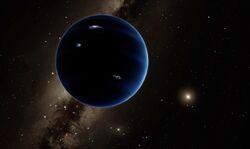
Planet Nine
Planet Nine is a hypothetical large planet in the far outer Solar System, the gravitational effects of which would explain the improbable orbital configuration of a group of trans-Neptunian objects (TNOs) that orbit mostly beyond the Kuiper belt.
In a 2014 letter to the journal Nature, astronomers Chad Trujillo and Scott S. Sheppard inferred the possible existence of a massive trans-Neptunian planet from similarities in the orbits of the distant trans-Neptunian objects Sedna and 2012 VP113. On 20 January 2016, researchers Konstantin Batygin and Michael E. Brown at Caltech explained how a massive outer planet would be the likeliest explanation for the similarities in orbits of six distant objects, and they proposed specific orbital parameters. The predicted planet would be a super-Earth, with an estimated mass of 10 Earths (approximately 5,000 times the mass of Pluto), a diameter two to four times that of Earth, and a highly elliptical orbit with an orbital period of approximately 15,000 years.
On the basis of models of planet formation that might include planetary migration from the inner Solar System, such as the five-planet Nice model, Batygin and Brown suggest that it may be a primordial giant planet core that was ejected from its original orbit during the nebular epoch of the Solar System's evolution. Others have proposed that it was captured from another star, or that it formed on a very distant circular orbit and was perturbed onto its current eccentric orbit during a distant encounter with another star.
Postulated characteristics[]
Orbit[]
Planet Nine is hypothesized to follow a highly elliptical orbit around the Sun, with an orbital period of 10,000–20,000 years. The period with which it goes around the sun is a rational multiple of the periods of all the furthest Kuiper Belt objects. The planet's orbit would have a semi-major axis of approximately 700 AU, or about 20 times the distance from Neptune to the Sun, although it might come as close as 200 AU (30 billion km, 19 billion mi), and its inclination estimated to be roughly 30°±10°. The high eccentricity of Planet Nine's orbit could take it as far away as 1,200 AU at its aphelion.
The aphelion, or farthest point from the Sun, would be in the general direction of the constellations of Orion and Taurus, whereas the perihelion, the nearest point to the Sun, would be in the general direction of the southerly areas of Serpens (Caput), Ophiuchus, and Libra.
Brown thinks that if Planet Nine is confirmed to exist, a probe could fly by it in as little as 20 years, with a powered slingshot around the Sun.
Size[]
The planet is estimated to have 10 times the mass and two to four times the diameter of Earth. An object with the same diameter as Neptune has not been excluded by previous surveys. An infrared survey by the Wide-field Infrared Survey Explorer (WISE) in 2009 allowed for a Neptune-sized object beyond 700 AU. A similar study in 2014 focused on possible higher-mass bodies in the outer Solar System and ruled out Jupiter-mass objects out to 26,000 AU.
Brown thinks that no matter where it is speculated to be, if Planet Nine exists, then its mass is higher than what is required to clear its feeding zone in 4.6 billion years, and thus that it dominates the outer edge of the Solar System, which is sufficient to make it a planet by current definitions. Using a metric based on work by Jean-Luc Margot, Brown calculated that only at the smallest size and farthest distance was it on the border of being called a dwarf planet. Margot himself says that Planet Nine satisfies the quantitative criterion for orbit-clearing developed by him in 2015, and that according to that criterion, Planet Nine will qualify as a planet—if and when it is detected.
Composition[]
Brown speculates that the predicted planet is most likely an ejected ice giant, similar in composition to Uranus and Neptune: a mixture of rock and ice with a small envelope of gas.
Fiction[]
 |
This page is under construction. Need help. |
| Stars | Sun |
|---|---|
| Planets | Mercury | Venus | Earth | Mars | Jupiter | Saturn | Uranus | Neptune | Planet Nine | Chaos | Nemesis |
| Dwarf Planets | Ceres | Pluto | Eris | Makemake | Haumea | Orcus | Sedna |
| Moons | Luna | Phobos | Deimos | Io | Sinope | Ganymede | Europa | Callisto | Amalthea | Metis | Megaclite | Himalia | Elara | Dia | Pasiphae | Lysithea | Carme | Callirrhoe | Themisto | Taygete | Adrastea | Chaldene | Harpalyke | Kalyke | Iocaste | Erinome | Isonoe | Praxidike | Autonoe | Thyone | Hermippe | Aitne | Titan | Hyperion | Enceladus | Tethys | Mimas | Dione | Rhea | Iapetus | Phoebe | Janus | Epimetheus | Helene | Telesto | Calypso | Atlas | Prometheus | Pandora | Pan | Methone | Pallene | S/2004 S 17 | Miranda | Titania | Ariel | Umbriel | Oberon | Triton | Thalassa | Proteus | Larissa | Despina | Charon | Nix | Hydra | Kerberos | Styx | Dysnomia | Vanth | Hiʻiaka | Namaka |
| Asteroids | Juno | Pallas | Vesta | Chiron | Ida | Dactyl |
| Other | Asteroid Belt | Kuiper Belt |
